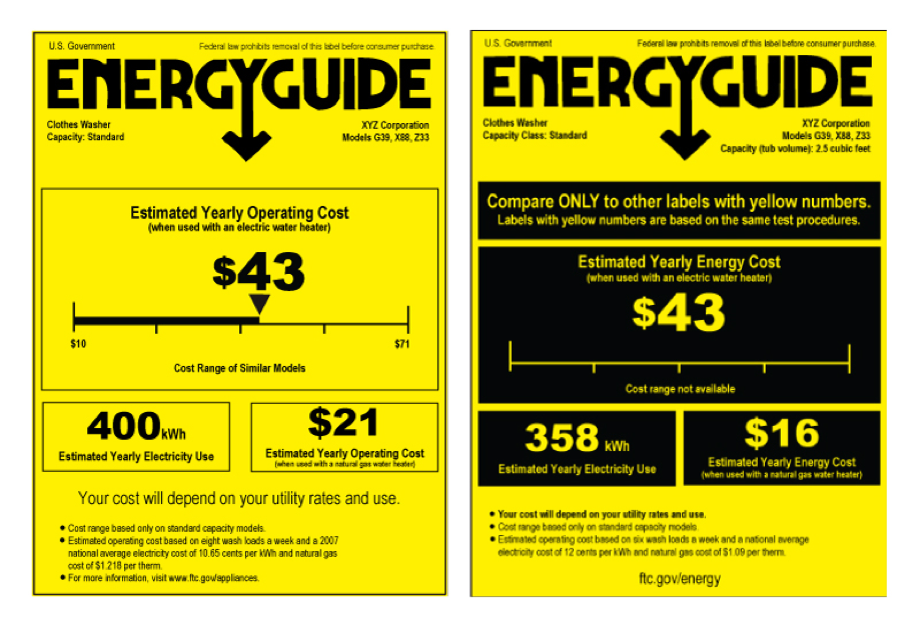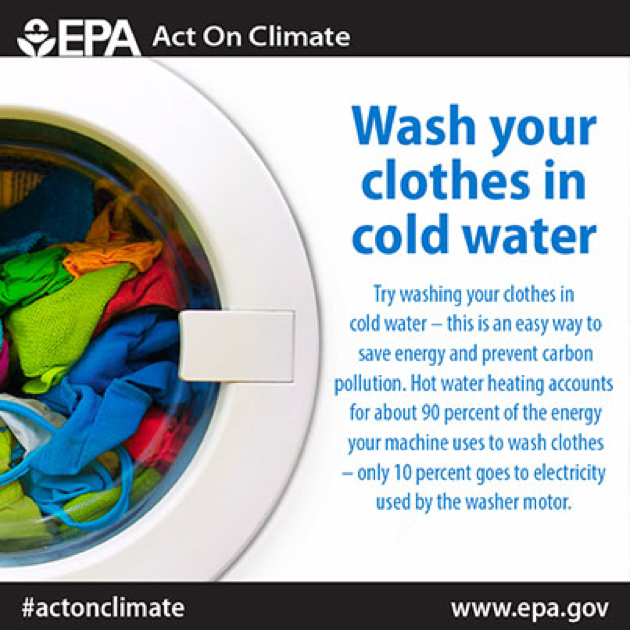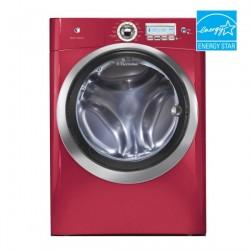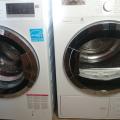Scope
Install a new clothes washer in a new home.
- Select an energy-efficient clothes washer.
- Look for ENERGY STAR-certified models.
- Install the new clothes washer.
See the Compliance Tab for links to related codes and standards and voluntary federal energy-efficiency program requirements.
Description
A clothes washer is an appliance that uses an automated sequence of mechanical operations to clean clothes using water and detergent. After a clothes washer is loaded and started, the clothing is either sprayed or soaked in a solution of water and detergent. Mechanical agitation or tumbling increases the cleaning action to lift out dirt. The contents are then rinsed and spun to extract as much moisture as possible.
Clothes washers are one of the major water-using components in the typical American home. The average American family washes nearly 400 loads of laundry each year. ENERGY STAR certified clothes washers can cut related water costs and usage by more than half and save enough money in operating costs to pay for the matching dryer. ENERGY STAR-certified clothes washers use advanced technologies to decrease energy use by 25% and water use by 45% compared to conventional clothes washers, according to the EPA (Figure 1). ENERGY STAR-certified models come in either front-load or top-load designs. Both configurations include technological innovations that help save energy and water. These innovations include
- sensors to monitor incoming water temperature closely
- high-pressure spray nozzles to rinse clothes instead of soaking in a full tub of water
- efficient motors to spin clothes two to three times faster during the spin cycle to extract more water. Less moisture in the clothes means less energy used by the dryer.
- front-loaders that tumble clothes through a small amount of water instead of rubbing clothes against an agitator in a full tub
- advanced top loaders that use sophisticated wash systems to flip or spin clothes through a reduced stream of water.

Clothes washers are one of the most popular household appliances. Approximately 83% of U.S. homes has a clothes washer, according to the Energy Information Administration’s 2015 Residential Energy Consumption Survey.
How to Install an Energy-Efficient Clothes Washer
1. Select a new energy-efficient clothes washer.
- Before choosing a new clothes washer (or helping the homeowner to choose a new clothes washer), use a tape measure to determine the space constraints in the spot designated for the clothes washer.
- Use a tape measure to determine the space constraints of doorways and hallways to ensure that the new model can be moved to its installation location.
- Choose a clothes washer model that meets the needs of the household. Options to consider include top load versus front load configuration, volume, features, connectivity, energy efficiency, and water efficiency.
- Use the ENERGY STAR Product Finder to identify and determine the energy use of new, ENERGY STAR-certified clothes washer models. You can also use data from the Product Finder to identify clothes washer models with connected functionality, which would allow the homeowner to save more money by engaging in demand response services from the utility company.
- Check the Database of State Incentives for Renewables & Efficiency® or the ENERGY STAR Rebate Finder to determine whether a clothes washer model is eligible for a rebate or incentive in your area.
- Compare EnergyGuide labels (Figure 2) as another way to identify energy-efficient models.

2. Install the new, energy-efficient clothes washer.
- Many appliance vendors will install the new clothes washer. If you are installing it, use the following installation instructions or see the manufacturer’s installation instructions.
- Use a dolly or hand truck to move the new clothes washer close to the area where it will be installed. Before doing so, put floor mats or paper along the route to protect the floor. Sweep out the clothes washer location to remove any dust or dirt.
- Remove the packaging from the clothes washer. Ask the homeowner to keep the box and packaging materials for a few days in case the unit has to be returned for replacement or repair.
- Make sure the clothes washer water supply lines are long enough for the new location. If not, purchase an extender or buy new lines in a longer length. Consider using flexible stainless steel hoses with rubber washers for longevity.
- Connect the water supply lines to the back of the clothes washer by hand or with the use of pipe pliers. Do not overtighten because that can cut the rubber washers and cause water leaks.
- Connect the other end of the water supply lines to the water supply valves, making sure the right lines connect to the right outlet valves (hot and cold) and making sure there are no kinks in the lines.
- Turn on the water valves and check for leaks at all connections. Run a piece of dry paper towel along the lines to check for leaks.
- Securely connect the drain line to the clothes washer using the clamp. Insert the drain line into the wall drain pipe. Check that the wall pipe is standing up straight and that the drain hose isn't pushed too far down the waste water drain pipe. New clothes washer drain hoses have a plastic hook on the end for clipping the drain hose, which prevents it from being pushed in too far. If you end up with water constantly filling the washer and emptying, the drain hose is pushed too far down the pipe.
- If the drain line isn’t long enough, you can extend it with a special connector and additional line from an aftermarket kit.
- Slowly slide or move the clothes washer into its designated space. Make sure that the water supply and drain lines are not kinked or compressed.
- Make sure the clothes washer is level. Using a level tool, adjust the feet beneath the clothes washer. This will reduce vibrations and help prevent leaks.
- Turn the power on at the breaker. Connect the electrical cord into a grounded three-prong outlet. Do not remove the ground prong, do not use an adapter, and do not use an extension cord. Failure to follow these instructions can result in fire or electrical shock.
- Check for leaks at the water connections over the next few hours. If any appear, turn off the water and tighten the compression fittings slightly. If no leaks appear, test run the clothes washer.
3. Set up an Internet-connected clothes washer.
- The clothes washer manufacturer will have an app available for download on a smartphone, tablet, or other mobile device. Download the app on your (or the homeowner’s) preferred device. The app will guide you through all of the steps to connect the clothes washer. Below are some general steps.
- Open the app on the device and sign in or create a WiFi connect account. This will associate any connected appliances with the homeowner’s device.
- Find the connected appliance information label on the clothes washer. This label contains the network name and password for the unit.
- In the app, type in the password from the information label.
- Go to the mobile device’s WiFi settings and choose the network name found on the information label. This will start the communication between the app and clothes washer.
- Once the communication between the mobile device and clothes washer is complete, the app will ask the user to choose the home network. Find the home’s WiFi network and enter the password to connect the device to this network.
- Communication between the mobile device and the home network will begin, connecting the clothes washer to the home network. The clothes washer is connected once the app says “connected.”
4. Provide product literature and instructions to the homeowner.
- Provide the home owner with any manufacturer product literature and warranty information.
- Submit, or supply to the homeowner to submit, paperwork for any applicable utility rebates or tax incentives.
- Provide the homeowner with tips for getting the most energy- and water-efficient performance from their clothes washer. Here are some resource-saving laundry tips for homeowners:
- For a front-loading or high-efficiency top-loading clothes washer, use detergent labeled for high-efficiency (HE) machines. According to the American Cleaning Institute, HE detergents are formulated for low suds and quick dispersal to clean well in high-efficiency washers that use less water.
- Wash clothes in cold water using cold-water detergents whenever possible (Figure 3).
- Wash and dry full loads. If washing a small load, use the appropriate water-level setting.
- Dry towels and heavier cottons in a separate load from lighter-weight clothes.
- Don't over-dry clothes. If the clothes washer has a moisture sensor, use it.
- Clean the lint screen in the dryer after every load to improve air circulation and prevent fire hazards.
- Periodically, use the long nozzle tip on a vacuum cleaner to remove the lint that collects below the lint screen in the lint screen slot of your clothes dryer.
- Use the cool-down cycle to allow the clothes to finish drying with the heat remaining in the dryer.
- Periodically inspect the dryer vent to ensure it is not blocked. This will save energy and may prevent a fire. Manufacturers recommend using rigid venting material -not plastic vents that may collapse and cause blockages.
- Consider air-drying clothes on clothes lines or drying racks. Air drying is recommended by clothing manufacturers for some fabrics.

Success
Look for the ENERGY STAR label on the clothes washers you buy and install.
Climate
No climate-specific information applies.
Training
Compliance
Retrofit
SCOPE
Install a new clothes washer as a replacement for an older clothes washer in an existing home.
- Select an energy-efficient, ENERGY STAR-certified clothes washer model.
- Remove and recycle the old clothes washer.
- Install the new ENERGY STAR-certified clothes washer.
- Please follow safe work practices as described in the U.S. Department of Energy’s Standard Work Specifications when removing or installing clothes washers in homes.
DESCRIPTION
Of the 83% of U.S. homes that have a clothes washer, nearly 9% have a model that is 15 years old or greater, according to the Energy Information Administration’s 2015 Residential Energy Consumption Survey. Homeowners with old clothes washers should consider planning ahead to purchase a new, ENERGY STAR-certified model to start saving money on energy and water bills before the current unit breaks down. By planning ahead, homeowners have the time to identify an ENERGY STAR-certified model that meets their needs rather than rushing the purchase decision.
How to Replace the Old Clothes Washer with an ENERGY STAR-Certified Model
1. Select a new energy-efficient clothes washer.
- See the Description tab for information on selecting the right model.
2. Disconnect and remove the old clothes washer.
- Plan ahead when helping homeowners remove and recycle their old clothes washers. Clothes washers contain metals and parts that can and should be recycled. In addition, depending on the area, improper disposal of appliances can be punishable by either a fine or jail time. Many municipalities offer curbside pickup of old appliances for little to no charge. Appliance recyclers will often remove and haul away an old clothes washer for a small fee. If the homeowner purchases a new clothes washer from a major retailer, the old unit can be hauled away at a small charge or for free when the new unit is delivered. The U.S. EPA Responsible Appliance Disposal (RAD) Program provides information on how to locate a recycler in the area.

- Collect these items to have ready when you disconnect and remove the old clothes washer: a bucket, old towels to absorb water, a dolly, some duct tape, ropes or bungee cords, tie-down straps, and one person to help. A helper is especially important if you have stairs to maneuver.
- Begin the process by turning off the water supply leading to the clothes washer. Make sure that both the hot and cold water valves are shut off.
- Shut off power to the clothes washer at the breaker panel and place a piece of tape over the breaker switch to ensure no one turns it back on while you’re working. Unplug the electrical cord. Secure the cord to the back of the machine using duct tape.
- Slowly pull the clothes washer out of its footprint. Position the bucket on the floor below the drain line and put an old towel below the drain line connection. Disconnect the drain line and pour the water remaining in the line into the bucket. Disconnect the drain line from the drain pipe. Pour the bucket out into the utility sink.
- Next, position the bucket on the floor below the water supply lines and put an old towel below the water supply line connections. Disconnect each water supply line separately and pour the remaining water into a bucket. Pour the bucket out into the garden or lawn.
- Duct tape the washer lid or door closed to prevent damage during loading and unloading.
- Carefully slide the clothes washer onto the dolly and center it for equal weight distribution. Secure the clothes washer with bungee cords or ropes for extra support especially if moving up or down stairs. Consider using floor mats or paper to protect the floor. Consider wrapping blankets or other soft material around the clothes washer to protect doorways or cabinetry.
- Secure the clothes washer to the vehicle using tie-down straps or bungee cords. Haul the clothes washer to the local recycler.
3. Install the new clothes washer.
- Many appliance vendors will install the new clothes washer. If you are installing it, use the installation instructions provided in the Description tab.
More
More Info.
Access to some references may require purchase from the publisher. While we continually update our database, links may have changed since posting. Please contact our webmaster if you find broken links.
The following authors and organizations contributed to the content in this Guide.
Pacific Northwest National Laboratory
Sales
High-Efficiency Clothes Washer = High-Efficiency Clothes Washer

High-efficiency clothes washers typically have earned the ENERGY STAR Qualified Appliance label. Ultra-efficient clothes washers are those that meet ENERGY STAR’s “Most Efficient” designation requirements.



